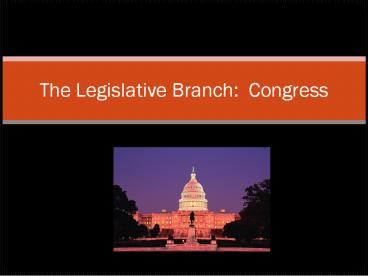The Legislative Branch: Congress - PowerPoint PPT Presentation
Title:
The Legislative Branch: Congress
Description:
The Legislative Branch: Congress The Evolution of Congress Intent of Framers Congress generally dominant over the presidency for more than 140 years. – PowerPoint PPT presentation
Number of Views:156
Avg rating:3.0/5.0
Title: The Legislative Branch: Congress
1
The Legislative Branch Congress
2
The Evolution of Congress
- Intent of Framers
- Congress generally dominant over the presidency
for more than 140 years. - Rise of party control
- Popular Election of Senators in 1913
3
Congressional Functions
- Representation
- Lawmaking
- Consensus building
- Overseeing (Oversight)
- Policy clarification
4
Who is in Congress?
- Requirements Senate 30 years old, a citizen
for 9 years and a resident of the state House of
Representatives 25 years old, a citizen for 7
years and a resident of the district he or she
represents. - Years of service No terms limits, thus the
incumbency effect - Party Affiliation
- Sex, race, religion?
5
According to C-Spans Membership of the 111th
Congress A Profile
- The average age of Members of both Houses of
Congress at the convening of the 111th Congress
is 58.2 years of Members of the House, 57.0
years and of Senators, 63.1 years. The
overwhelming majority of Members have a college
education. The dominant professions of Members
are public service/politics, business, and law.
Protestants collectively constitute the majority
religious affiliation of Members. Roman Catholics
account for the largest single religious
denomination, and numerous other affiliations are
represented. - A record number of 95 women serve in the 111th
Congress 78 in the House, 17 in the Senate.
There are 41 African American Members of the
House and none in the Senate. This number
includes two Delegates. There are 31 Hispanic or
Latino Members serving 28 in the House,
including the Resident Commissioner, and three in
the Senate. Eleven Members (seven
Representatives, two Delegates, and two Senators)
are Asian or Native Hawaiian/other Pacific
Islander. The only American Indian (Native
American) serves in the House.
6
112th Congress
- The average age of Members of the House at the
beginning of the 112th Congress was 56.7 years
and of Senators, 62.2 years. The overwhelming
majority of Members have a college education. The
dominant professions of Members are public
service/politics, business, and law. Protestants
collectively constitute the majority religious
affiliation of Members. Roman Catholics account
for the largest single religious denomination,
and numerous other affiliations are represented - Ninety-one women serve in the 112th Congress 74
in the House, including 3 Delegates, and 17 in
the Senate. There are 44 African American Members
of the House (a record number) and none in the
Senate. This House number includes two Delegates.
There are 28 Hispanic or Latino Members serving
26 in the House, including the Resident
Commissioner, and 2 in the Senate. Thirteen
Members (nine Representatives, two Delegates, and
two Senators) are Asian or Native Hawaiian/other
Pacific Islander. The only American Indian
(Native American) serves in the House. - Source www.Senate.gov
7
Getting Elected
- Representatives elected from single member
districts - Senators serve six year terms and Representatives
serve two year terms. One-third of the senators
are up for re-election every two years, making
the Senate a continuous body. - Problem of drawing district boundaries
(gerrymandering) - Congress decides size of the House of
Representatives reapportioned every 10 years - The incumbency effect occurs due to name
recognition, casework for constituents, media
exposure, experience, voting records. - No term limits.
8
Organization of Congress
- Senate leaders are the majority leader and the
minority leader. The Vice President is the
President of the Senate. - The Speaker of the House is the leader of the
House of Representatives. - Party whips keep leaders informed
- Senate Policy Committee gives senators
- committee assignments
- House Rules committee controlled by the
Speaker of the House - Party of majority controls all committee chairs
and majority members of every committee
9
Types of Committees
- Standing Committees, Select Committees, Joint
Committees, Joint Conference Committees - The Senate has 20 committees, 68 subcommittees
and four joint committees including Foreign
Relations, Armed Services, Health, Education,
Labor and Pensions and Homeland Security and
Governmental Affairs (see www.senate.gov for full
listing and specific information.) - The House of Representatives has 22 committees
and more than 100 subcommittees including
Agriculture, Education and Labor, Rules, Science
and Technology and Ways and Means (see
www.House.gov for full listing and specific
information.)
10
Roles and Privileges of Members of Congress
- Roles
- Policymaker
- Representative (Delegate or Trustee?)
- Constituent Servant
- Committee Member
- Politician/Party Member
- Privileges
- Offices and staff
- Travel allowances
- Franking privilege
- Immunity from certain charges
11
Congressional Powers
- Delegated Powers Article I, Section 8 - tax,
defend, borrow money, regulate commerce, raise
and regulate an army, declare war - Implied Powers Article I, Section 8, Clause 18,
Necessary and Proper Clause, Elastic Clause - The Senate has the power to confirm presidential
nominations such as Supreme Court justices,
ambassadors, federal judges, ratify treaties and
hold impeachment trials. - All revenue bills (raising taxes) must start in
the House. - Congress can also override a presidential veto
and initiate amendments. - Oversight Power
12
How a Bill Becomes a Law
- http//bensguide.gpo.gov/9-12/lawmaking/index.html
- When debating a bill, the Senate may use the
filibuster, but the House debate is limited. The
Rule of Cloture ends a filibuster.
13
Legislative Tactics
- Caucuses
- The Committee System
- Filibuster and cloture
- Pork Barrel Legislation
- Logrolling
- Riders
- Amendments
- Lobbying
- Legislative veto (used between 1932 and 1980, but
declared unconstitutional in 1983.
14
Influences on Lawmakers
- Ideology
- Colleagues
- Staff
- Party
- President
- Constituents
- Lobbyists and Special Interest Groups































